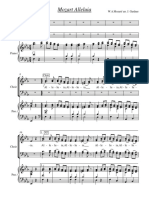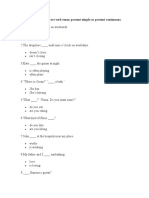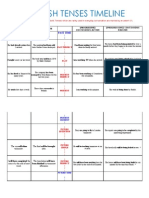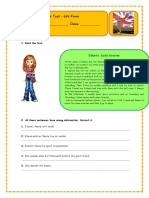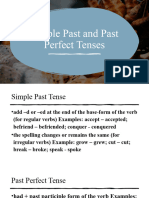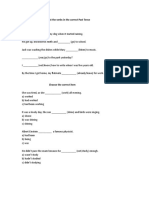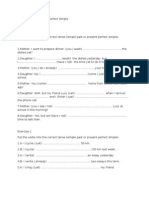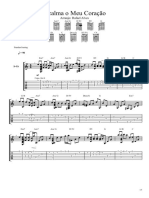Past Simple Vs Past Continuous
Past Simple Vs Past Continuous
Uploaded by
Paula DiazCopyright:
Available Formats
Past Simple Vs Past Continuous
Past Simple Vs Past Continuous
Uploaded by
Paula DiazOriginal Title
Copyright
Available Formats
Share this document
Did you find this document useful?
Is this content inappropriate?
Copyright:
Available Formats
Past Simple Vs Past Continuous
Past Simple Vs Past Continuous
Uploaded by
Paula DiazCopyright:
Available Formats
Simple Past
The simple past (also called past simple, past indefinite or preterite) is a verb
tense which is used to show that a completed action took place at a specific
time in the past. The simple past is also frequently used to talk about past
habits and generalizations. Read on for detailed descriptions, examples, and
simple past exercises.
Simple Past Forms
The simple past is formed using the verb + ed. In addition, there are
many verbs with irregular past forms. Questions are made with did and negative
forms are made with did not.
Statement: You called Debbie.
Question: Did you call Debbie?
Negative: You did not call Debbie.
Complete List of Simple Past Forms
Simple Past Uses
USE 1 Completed Action in the Past
Use the simple past to express the idea that an action started and finished at a
specific time in the past. Sometimes, the speaker may not actually mention the
specific time, but they do have one specific time in mind.
Examples:
I saw a movie yesterday.
I didn't see a play yesterday.
Last year, I traveled to Japan.
Last year, I didn't travel to Korea.
Did you have dinner last night?
She washed her car.
He didn't wash his car.
USE 2 A Series of Completed Actions
We use the simple past to list a series of completed actions in the past. These
actions happen 1st, 2nd, 3rd, 4th, and so on.
Examples:
I finished work, walked to the beach, and found a nice place to swim.
He arrived from the airport at 8:00, checked into the hotel at 9:00, and met the
others at 10:00.
Did you add flour, pour in the milk, and then add the eggs?
USE 3 Duration in the Past
The simple past can be used with a duration which starts and stops in the past.
A duration is a longer action often indicated by expressions such as: for two
years, for five minutes, all day, all year, etc.
Examples:
I lived in Brazil for two years.
Shauna studied Japanese for five years.
They sat at the beach all day.
They did not stay at the party the entire time.
We talked on the phone for thirty minutes.
A: How long did you wait for them?
B: We waited for one hour.
USE 4 Habits in the Past
The simple past can also be used to describe a habit which stopped in the past.
It can have the same meaning as "used to." To make it clear that we are talking
about a habit, we often add expressions such as: always, often, usually, never,
when I was a child, when I was younger, etc.
Examples:
I studied French when I was a child.
He played the violin.
He didn't play the piano.
Did you play a musical instrument when you were a kid?
She worked at the movie theater after school.
They never went to school, they always skipped class.
Affirmative Negative Question
She was excited She wasn´t excited Was she excited?
They were in class They weren´t in class Were they in class?
You studied English You didn´t study English Did you study English?
She went to New York She didn´t go to New York Did she go to New York?
Past Continuous
Past Continuous Forms
The past continuous is formed using was/were + present participle. Questions
are indicated by inverting the subject and was/were. Negatives are made
with not.
Statement: You were studying when she called.
Question: Were you studying when she called?
Negative: You were not studying when she called.
Complete List of Past Continuous Forms
Past Continuous Uses
USE 1 Interrupted Action in the Past
Use the past continuous to indicate that a longer action in the past was
interrupted. The interruption is usually a shorter action in the simple past.
Remember this can be a real interruption or just an interruption in time.
Examples:
I was watching TV when she called.
When the phone rang, she was writing a letter.
While we were having the picnic, it started to rain.
What were you doing when the earthquake started?
I was listening to my iPod, so I didn't hear the fire alarm.
You were not listening to me when I told you to turn the oven off.
While John was sleeping last night, someone stole his car.
Sammy was waiting for us when we got off the plane.
While I was writing the email, the computer suddenly went off.
A: What were you doing when you broke your leg?
B: I was snowboarding.
USE 2 Specific Time as an Interruption
In USE 1, described above, the past continuous is interrupted by a shorter
action in the simple past. However, you can also use a specific time as an
interruption.
Examples:
Last night at 6 PM, I was eating dinner.
At midnight, we were still driving through the desert.
Yesterday at this time, I was sitting at my desk at work.
IMPORTANT
In the simple past, a specific time is used to show when an action began or
finished. In the past continuous, a specific time only interrupts the action.
Examples:
Last night at 6 PM, I ate dinner.
I started eating at 6 PM.
Last night at 6 PM, I was eating dinner.
I started earlier; and at 6 PM, I was in the process of eating dinner.
USE 3 Parallel Actions
When you use the past continuous with two actions in the same sentence, it
expresses the idea that both actions were happening at the same time. The
actions are parallel.
Examples:
I was studying while he was making dinner.
While Ellen was reading, Tim was watching television.
Were you listening while he was talking?
I wasn't paying attention while I was writing the letter, so I made several
mistakes.
What were you doing while you were waiting?
Thomas wasn't working, and I wasn't working either.
They were eating dinner, discussing their plans, and having a good time.
You might also like
- Suzuki BeaneDocument95 pagesSuzuki BeaneJacob Reider91% (22)
- Parveen Babi: A LifeDocument2 pagesParveen Babi: A LifeFirstpost67% (3)
- Entry Test Inglese Terza MediaDocument13 pagesEntry Test Inglese Terza Mediang68fmphhx100% (1)
- Mozart Alleluia: ChoirDocument3 pagesMozart Alleluia: ChoirSebastian Palacio VélezNo ratings yet
- The History of R&B Music Part 6: The 2000'sDocument49 pagesThe History of R&B Music Part 6: The 2000'sTimothy100% (2)
- PAST PERFECT SIMPLE (Vs. PAST SIMPLE) PracticeDocument2 pagesPAST PERFECT SIMPLE (Vs. PAST SIMPLE) PracticeIvana ParadinaNo ratings yet
- FACE TO FACE PRE INTERMEDIATE - Unit 5 TestDocument3 pagesFACE TO FACE PRE INTERMEDIATE - Unit 5 TestSonia GarciaNo ratings yet
- Present Simple: Evelyn'S Daily RoutineDocument7 pagesPresent Simple: Evelyn'S Daily RoutineValentina Parra C100% (1)
- Otp Unit 1Document3 pagesOtp Unit 1Ana Maria Kuckiewicz100% (1)
- Narrative TensesDocument1 pageNarrative TensesZorica ArnaudovaNo ratings yet
- Will (Advanced Uses)Document5 pagesWill (Advanced Uses)Laura Paola Torres DíazNo ratings yet
- Indefinite PronounsDocument1 pageIndefinite PronounsIvàn RamìrezNo ratings yet
- Present Simple Vs Present ContinousDocument3 pagesPresent Simple Vs Present ContinousFrida Gabriela GCNo ratings yet
- Irregular Verbs Simple PastDocument1 pageIrregular Verbs Simple PastadelebookNo ratings yet
- Used To Be Used To Get Used To Grammar Drills 62033Document2 pagesUsed To Be Used To Get Used To Grammar Drills 62033Alonso PachasNo ratings yet
- Present and Past Participle Clause W KeyDocument2 pagesPresent and Past Participle Clause W KeyAndreia SimõesNo ratings yet
- Using of So Too Either Neither PDFDocument4 pagesUsing of So Too Either Neither PDFIta Beta KrisnitaNo ratings yet
- Be Going To ExercisesDocument1 pageBe Going To Exercisesanasmateussa2078No ratings yet
- Adjectives-And-Adverbs WKSHTDocument3 pagesAdjectives-And-Adverbs WKSHTJhiv PieNo ratings yet
- Life As A Youtuber - WorksheetDocument4 pagesLife As A Youtuber - WorksheetNicole ScheferNo ratings yet
- English Tense Timeline QuerformatDocument3 pagesEnglish Tense Timeline QuerformatqkhaiproNo ratings yet
- Past Simple Used To WouldDocument2 pagesPast Simple Used To WouldJose Luis LanchipaNo ratings yet
- Past Simple or ContDocument5 pagesPast Simple or ContAntoni Roden-BurnsNo ratings yet
- Упражнение must mustn'tDocument3 pagesУпражнение must mustn'tАлена ХитрукNo ratings yet
- English Test - 6th Form Name: - ClassDocument4 pagesEnglish Test - 6th Form Name: - Classaygul100% (1)
- (Type Text) : Match The Holiday Accidents With The PicturesDocument4 pages(Type Text) : Match The Holiday Accidents With The PicturesMaria MolinaNo ratings yet
- WRITING 1 Creating TalesDocument2 pagesWRITING 1 Creating TalesEdwin GuzmánNo ratings yet
- Test Intermediate 2. FinalDocument3 pagesTest Intermediate 2. FinalLUIS MANUEL GONZALES DELGADONo ratings yet
- Present Perfect Vs Simple PastDocument2 pagesPresent Perfect Vs Simple Pasteduardoallgayer1No ratings yet
- Advanced - Participle, To-Infinitive ClausesDocument4 pagesAdvanced - Participle, To-Infinitive ClausesDori Pérez CruzNo ratings yet
- Simple Past and Past Perfect TensesDocument13 pagesSimple Past and Past Perfect TensesSincerly Revellame100% (1)
- Modal Auxiliary Verbs - Will and WouldDocument2 pagesModal Auxiliary Verbs - Will and WouldTyas Kusuma NingrumNo ratings yet
- Revision:: Past Tense ContrastDocument3 pagesRevision:: Past Tense ContrastRobNo ratings yet
- Indefinite PronounsDocument3 pagesIndefinite PronounsvericliNo ratings yet
- Test The Present SimpleDocument7 pagesTest The Present SimpleЧерниш Марина ВіталіївнаNo ratings yet
- Past Simple and ContinuousDocument4 pagesPast Simple and ContinuousandreamduarteNo ratings yet
- FCE Sentence Transformation 1Document3 pagesFCE Sentence Transformation 1Willy De DooyNo ratings yet
- Quiz Conditional 1 and 2Document2 pagesQuiz Conditional 1 and 2Simona BucurNo ratings yet
- Used To WouldDocument3 pagesUsed To Wouldroxana kwiekNo ratings yet
- Verb Tense ExerciseDocument2 pagesVerb Tense ExerciseEugenia IgounetNo ratings yet
- Would Rather Had Better High TimeDocument6 pagesWould Rather Had Better High Timelakmus6100% (1)
- Present Perfect Grammar-Speaking TaskDocument10 pagesPresent Perfect Grammar-Speaking TaskDanny Riofrio CornelNo ratings yet
- Past Simple TenseDocument1 pagePast Simple TenseArsalan A. RajputNo ratings yet
- MAKE QUESTIONS For The Underlined PartsDocument2 pagesMAKE QUESTIONS For The Underlined Partsgrzincic7623No ratings yet
- Conditional and Modal NewDocument6 pagesConditional and Modal NewBitew Ayalew100% (1)
- Advise, Ask, Beg, Command, Order, TellDocument2 pagesAdvise, Ask, Beg, Command, Order, TellNelson Torres AbantoNo ratings yet
- 0 ConditionalDocument11 pages0 ConditionalEl PepeNo ratings yet
- Verbs of Perception With Infinitive or GerundDocument2 pagesVerbs of Perception With Infinitive or GerundrosiebubblymeNo ratings yet
- B1 Present Perfect Tense: Simple and Progressive T041Document2 pagesB1 Present Perfect Tense: Simple and Progressive T041SABA ALINo ratings yet
- Present Continuous For Future UseDocument1 pagePresent Continuous For Future UseYessenia LizasoaínNo ratings yet
- Past Tenses Review A2Document3 pagesPast Tenses Review A2yoga1312No ratings yet
- 2021-2022 ACADEMIC YEAR: 9 Ahs-ShsDocument2 pages2021-2022 ACADEMIC YEAR: 9 Ahs-ShsFulden AkdoğanNo ratings yet
- 28 - Too, Either, So Am I, Neither Do I.Document2 pages28 - Too, Either, So Am I, Neither Do I.Manuel Ignacio Martínez SánchezNo ratings yet
- Verb Form ExercisesDocument6 pagesVerb Form ExercisesNahia Aznar GonzalezNo ratings yet
- Future Tense - InfinitivesDocument7 pagesFuture Tense - InfinitivesKartika TarwatiNo ratings yet
- Past Simple Vs ContinuousDocument4 pagesPast Simple Vs ContinuousPatrycja BrengoszewskaNo ratings yet
- Simple Past and Past ContinuousDocument3 pagesSimple Past and Past ContinuousDuddy EffNo ratings yet
- Simple Past or Present Perfect SimpleDocument6 pagesSimple Past or Present Perfect SimpleElisg76No ratings yet
- Perfect Tenses PracticeDocument3 pagesPerfect Tenses PracticeJuan Pablo Moreno BuenoNo ratings yet
- Simple PastDocument8 pagesSimple Pastnavarreterobinson1No ratings yet
- Past TenseDocument14 pagesPast Tensepandu MNo ratings yet
- Present Simple: Does He Play Tennis?Document7 pagesPresent Simple: Does He Play Tennis?Marija MarkovićNo ratings yet
- Past Simple Past ContinuousDocument13 pagesPast Simple Past ContinuousbiffinNo ratings yet
- World Music. Study Unit 6.3 South African Popular Music.Document9 pagesWorld Music. Study Unit 6.3 South African Popular Music.Pristina1No ratings yet
- James Mursell, The Psychology of Music (New York: W. W. Norton & Company Inc., 1970), 29Document70 pagesJames Mursell, The Psychology of Music (New York: W. W. Norton & Company Inc., 1970), 29Başak DoğanNo ratings yet
- New! New! New!: Se Series ST Worn Out RW Black Se Series ST Worn Out MN Blonde Se Series TL Worn Out SH WhiteDocument1 pageNew! New! New!: Se Series ST Worn Out RW Black Se Series ST Worn Out MN Blonde Se Series TL Worn Out SH Whitealessio benedettiNo ratings yet
- Sweet Victory - Marching BandDocument24 pagesSweet Victory - Marching BandSalvador BarbosaNo ratings yet
- Between Music Lessons - How To Practice - Gerardy, Riki - 2003 - Edgware - Zelia - 9780954467517 - Anna's ArchiveDocument76 pagesBetween Music Lessons - How To Practice - Gerardy, Riki - 2003 - Edgware - Zelia - 9780954467517 - Anna's ArchivedermordNo ratings yet
- Smoke Gets in Your EyesDocument2 pagesSmoke Gets in Your EyesOreste VerdeNo ratings yet
- Acalma o Meu Coração (Tablatura)Document5 pagesAcalma o Meu Coração (Tablatura)Carlos Rodrigues100% (1)
- CPAR (Lesson 01 & 02)Document6 pagesCPAR (Lesson 01 & 02)judyanamikaelaaragoNo ratings yet
- Lab 38Document3 pagesLab 38Dasha DobrutskaNo ratings yet
- Banquet of MusicDocument25 pagesBanquet of MusicFederico Agustín AlcarazNo ratings yet
- 02 Flute1 RadetzkyMarchDocument2 pages02 Flute1 RadetzkyMarchBandaidNo ratings yet
- Cifra Club - Ricky Martin - Livin' La Vida LocaDocument4 pagesCifra Club - Ricky Martin - Livin' La Vida LocaMimi UwUNo ratings yet
- Concert Essay #1: Schumann's MärchenerzählungenDocument4 pagesConcert Essay #1: Schumann's MärchenerzählungenTony BuiNo ratings yet
- Wrath - of - BingUS CelloDocument2 pagesWrath - of - BingUS CelloChokchai LinNo ratings yet
- Forward To BernsteinDocument17 pagesForward To BernsteinNicolás Javier Palma MirandaNo ratings yet
- 17 Roxanne - Violin 1Document3 pages17 Roxanne - Violin 1MiguelMongeNo ratings yet
- DIY Multipurpose Circle of FifthsDocument35 pagesDIY Multipurpose Circle of FifthsJúlio CarvalhoNo ratings yet
- Information To UsersDocument167 pagesInformation To UsersTrisha VenturaNo ratings yet
- Romeiro Ao Lonxe: Luar Na Lubre Edle JulveDocument4 pagesRomeiro Ao Lonxe: Luar Na Lubre Edle JulveEdle JulveNo ratings yet
- Love PoemsDocument10 pagesLove PoemstotsyototsNo ratings yet
- The Continuity ScriptDocument265 pagesThe Continuity ScriptMartin CrewesNo ratings yet
- Nursery RhymeDocument2 pagesNursery RhymeGabrielNo ratings yet
- The Effect of Music On Stress and Anxiety ReductionDocument5 pagesThe Effect of Music On Stress and Anxiety ReductionMutuma GakuleNo ratings yet
- NATIONAL - ANTHEM - OF - INDIA - JANA - GANA - MANA Notes and TabsDocument3 pagesNATIONAL - ANTHEM - OF - INDIA - JANA - GANA - MANA Notes and TabsAnnetta shibuNo ratings yet
- Zorba The Greek (Fingerstyle)Document8 pagesZorba The Greek (Fingerstyle)computers0sNo ratings yet
- 0 - Workshop I English Iv 2022Document3 pages0 - Workshop I English Iv 2022Majo VargasNo ratings yet



